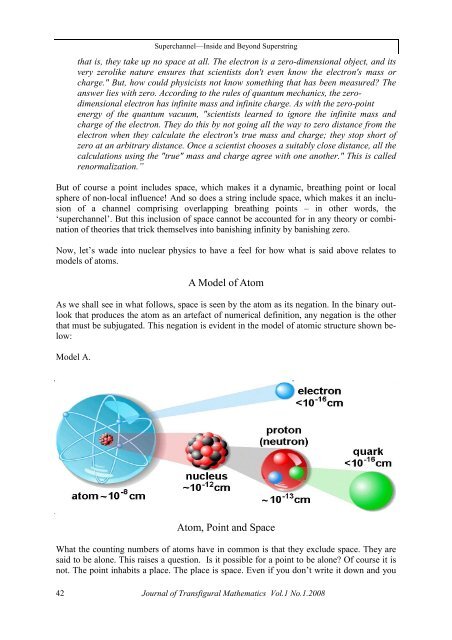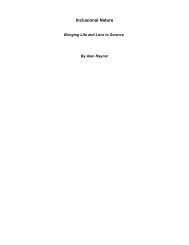JTfM Vol 1 No 1 2008 - ONLINE EDITION - Inclusionality Research
JTfM Vol 1 No 1 2008 - ONLINE EDITION - Inclusionality Research
JTfM Vol 1 No 1 2008 - ONLINE EDITION - Inclusionality Research
You also want an ePaper? Increase the reach of your titles
YUMPU automatically turns print PDFs into web optimized ePapers that Google loves.
that is, they take up no space at all. The electron is a zero-dimensional object, and its<br />
very zerolike nature ensures that scientists don't even know the electron's mass or<br />
charge." But, how could physicists not know something that has been measured? The<br />
answer lies with zero. According to the rules of quantum mechanics, the zerodimensional<br />
electron has infinite mass and infinite charge. As with the zero-point<br />
energy of the quantum vacuum, "scientists learned to ignore the infinite mass and<br />
charge of the electron. They do this by not going all the way to zero distance from the<br />
electron when they calculate the electron's true mass and charge; they stop short of<br />
zero at an arbitrary distance. Once a scientist chooses a suitably close distance, all the<br />
calculations using the "true" mass and charge agree with one another." This is called<br />
renormalization.”<br />
But of course a point includes space, which makes it a dynamic, breathing point or local<br />
sphere of non-local influence! And so does a string include space, which makes it an inclusion<br />
of a channel comprising overlapping breathing points – in other words, the<br />
‘superchannel’. But this inclusion of space cannot be accounted for in any theory or combination<br />
of theories that trick themselves into banishing infinity by banishing zero.<br />
<strong>No</strong>w, let’s wade into nuclear physics to have a feel for how what is said above relates to<br />
models of atoms.<br />
A Model of Atom<br />
As we shall see in what follows, space is seen by the atom as its negation. In the binary outlook<br />
that produces the atom as an artefact of numerical definition, any negation is the other<br />
that must be subjugated. This negation is evident in the model of atomic structure shown below:<br />
Model A.<br />
Superchannel—Inside and Beyond Superstring<br />
Atom, Point and Space<br />
What the counting numbers of atoms have in common is that they exclude space. They are<br />
said to be alone. This raises a question. Is it possible for a point to be alone? Of course it is<br />
not. The point inhabits a place. The place is space. Even if you don’t write it down and you<br />
42<br />
Journal of Transfigural Mathematics <strong>Vol</strong>.1 <strong>No</strong>.1.<strong>2008</strong>




